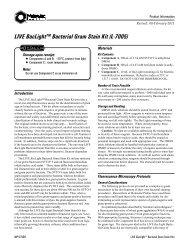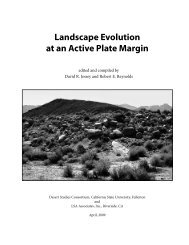Vertical Vegetation Structure Below Ground: Scaling from Root
Vertical Vegetation Structure Below Ground: Scaling from Root
Vertical Vegetation Structure Below Ground: Scaling from Root
Create successful ePaper yourself
Turn your PDF publications into a flip-book with our unique Google optimized e-Paper software.
<strong>Vertical</strong> <strong>Vegetation</strong> <strong>Structure</strong> <strong>Below</strong> <strong>Ground</strong>: <strong>Scaling</strong> <strong>from</strong> <strong>Root</strong> to Globe 351Many other studies that address variables structuring root systems ofindividual species could be mentioned here,but reviewing such studieswould be of limited value in the context of this chapter because the speciesis not a useful unit for scaling up <strong>from</strong> individuals to communities andbiomes. Theoretically,phylogeny may play a role in structuring communities,butthere is currently a lack of evidence to support such a role (Silvertownet al. 2001),and therefore no way to scale up <strong>from</strong> species-specifictraits to properties of communities or ecosystems (Naeem and Wright2003). Of course,if one had data on typical morphologies and sizes of rootsystems for all plant species within a given region one could probably usethis information to predict vertical root distributions at the plant communitylevel. Such detailed information on multiple species is actually available,butonly for very few regions. Over the last century a handful ofresearchers have excavated hundreds of root systems and documented theirmorphologies in detailed drawings,for example John Weaver in the NorthAmerican Midwest (1919,1920),M.S. Shalyt in the Ukraine and inKazakhstan (1950,1952),Isa Baitulin in Kazakhstan and Mongolia (1979,1993),and Lore Kutschera,Erwin Lichtenegger,and colleagues in centralEurope (many volumes,<strong>from</strong> Kutschera 1960 to Kutschera and Lichtenegger2002). The importance of this ground- and backbreaking work for ourunderstanding of the variability of root system morphology and speciesspecificdifferences can hardly be overstated. However,in order to use thismassive amount of information for predictions at the community level itfirst has to be converted into quantitative data.Scanned drawings of root systems have been used to quantify rootsystem sizes and shapes (Sun et al. 1997) and to analyze differences betweenroot systems of different plant growth forms and quantify relationshipsbetween root system sizes,climate,and soil characteristics (Schenk andJackson 2002b),as well as for analyses of plant allometry (Casper et al.2003). Strong allometric relationships exist between the volumes occupiedby individual plant canopies and the volumes occupied by their root systems,andthese relationships span taxonomically and ecologically diversespecies across ten orders of magnitude of size (Karl J. Niklas,H.J. Schenk,and R.B. Jackson,unpubl. data). Variance in aboveground sizes statisticallyaccounts for a large proportion of the variance in root system sizes betweenplant growth forms (Fig. 4; Schenk and Jackson 2002b). As a case in point,no differences in rooting depths or lateral root spreads were found in ananalysis of large numbers of species of perennial grasses and perennialforbs,two growth forms that typically differ substantially in above- andbelowground plant architecture,but have similar size ranges (Schenk andJackson 2002b). These growth forms may differ in the architecture of rootsinvolved in anchorage,but the volume of a root system is defined by the
















